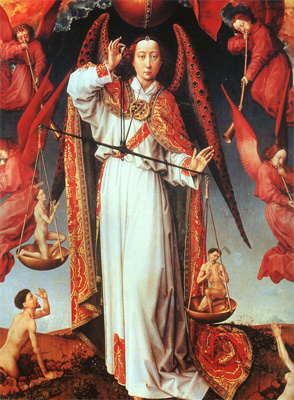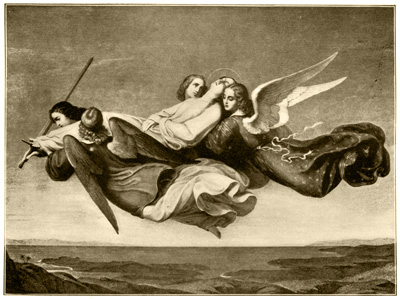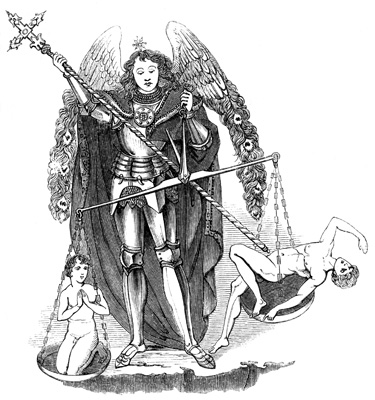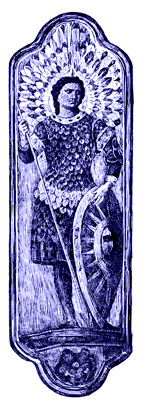The representations of St. Michael as the Lord of Souls are less numerous than those of the subjects mentioned in Part 1, but are very interesting. In some votive pictures he appears as the protector of those who have struggled with evil, and gained a victory. In such pictures the angel has his foot upon the dragon, or holds a dragon’s head in his hand, and bears the banner of victory.
Again, Michael is represented with his scales engaged in weighing the souls of the dead; in such pictures he is unarmed, and bears a sceptre ending in a cross. The souls are typified by little naked human figures; the accepted spirits usually kneel in the scales, with hands clasped as in prayer; the attitude of the rejected souls expresses horror and agony, which is sometimes emphasized by the figure of a demon, impatient for his prey, who reaches out his talons, or his devil’s fork, to seize the doomed spirits.
 Archangel Michael as the Lord of Souls from The Last Judgment
Archangel Michael as the Lord of Souls from The Last Judgment
by Rogier van der Weden
Leonardo da Vinci represented the angel as presenting the balance to the Infant Jesus, who has the air of blessing the pious soul in the upper scale. Signorelli, about 1500, painted a picture of this subject, which is in the church of San Gregorio at Rome, in which the archangel, in a suit of mail, stands with his wings spread out, and the balance with full scales held above a fierce, open-mouthed dragon. The lance of the archangel has pierced through the under jaw of the beast and entered his body, making an ugly wound, and a hideous little demon, resting on his tiny black wings, is clutching the condemned spirits in the lower scale.
In pictures of the Assumption or Glorification of the Virgin, if St. Michael is present, it is in his office of Lord of Souls, as the legends of the Madonna teach that he received her spirit, and guarded it until it was again united with her sinless form.
 The Translation of St. Catherine of Alexandria
The Translation of St. Catherine of Alexandria
by Heinrich Mucke
As Lord of Souls it is taught that St. Michael conducted the spirits of the just to heaven, and even cared for their bodies in some instances. The legend of St. Catherine of Alexandria teaches that her body was borne by angels over the desert and sea to the top of Mount Sinai, where it was buried, and later a monastery was built over her sepulchre. In the picture of the Translation of St. Catherine, shown above, St. Michael is one of the four celestial bearers of the martyr saint.
In rare instances St Michael was represented without wings. Such a figure standing on a dragon is a St. George, unless the balance is introduced. When the archangel stands upon the dragon with the balance in his hand, he appears in his double office as Conqueror of Satan and Lord of Souls. Memorial chapels and tombs were frequently decorated with this subject, a notable instance being that on the tomb of Henry VII., in Westminster Abbey.
In pictures of the Last Judgment, St. Michael is sometimes seen in the very act of weighing souls, symbolizing those of whom St. Paul said, “We shall not all sleep, but we shall all be changed, in a moment, in the twinkling of an eye, at the last trump: for the trumpet shall sound, and the dead shall be raised incorruptible, and we shall be changed.”
Since the Archangel Michael was made the guardian of the Hebrew nation, he was naturally an important actor in many scenes connected with their history. It was he who succored Hagar in the wilderness (Genesis xxi., 17), who appeared to restrain Abraham from the sacrifice of Isaac (Genesis xxii., 1 1). He brought the plagues on Egypt and led the Israelites on their journey. The Jews and early Christians believed that God spoke through the mouth of Michael in the Burning Bush, and by him sent the law to Moses on Mount Sinai. When Satan would have entered the body of Moses, in order to personate the prophet and deceive the Jews, it was Michael who contended with the Evil One, and buried the body in an unknown place, as is distinctly stated by Jude. Signorelli chose this as the subject of one of his frescoes in the Sistine Chapel.
It was Michael who put blessings instead of curses into Balaam’s mouth (Numbers xxii., 35), who was with Joshua in the plain of Jericho (Joshua v., 13), who appeared to Gideon (Judges vi., 2), and delivered the three faithful Jews from the fiery furnace (Daniel iii., 25). This last subject is one of the earliest in Christian art, and was a symbol of the redemption of man by Jesus Christ. There are still other like offices which St. Michael filled as the protector of the Jews, while several important works are attributed to him in the Apochrypha and in the Legends of the Church.
For example, in the apocryphal story of Bel and the Dragon, it is related that when King Cyrus had thrown the prophet Daniel into the lions’ den, and he had been six days without food, the angel of the Lord appeared to the prophet Habakkuk in Jewry, when he had prepared a mess of potage for the reapers in his field, and the angel commanded Habakkuk to carry the potage to Babylon and give it to Daniel.
“Then Habakkuk said, ‘Lord, I never saw Babylon; neither do I know where the den is.’ Then the angel of the Lord took Habakkuk by the hair of his head, and set him in Babylon over the lions’ den, and Habakkuk cried, saying, ‘O Daniel, Daniel, take the dinner which God hath sent thee,’ and the angel again set Habakkuk in his own place.”
At one period this subject was represented on sarcophagi, but it can also be found in prints after the Flemish artist, Hemshirk.
Source: Clement, Clara Erskine. Angels in Art. Boston: L. C. Page and Company, 1898.
Find free images of Michael the Archangel at Christian Image Source.
 Archangel Michael
Archangel Michael Archangel Art
Archangel Art